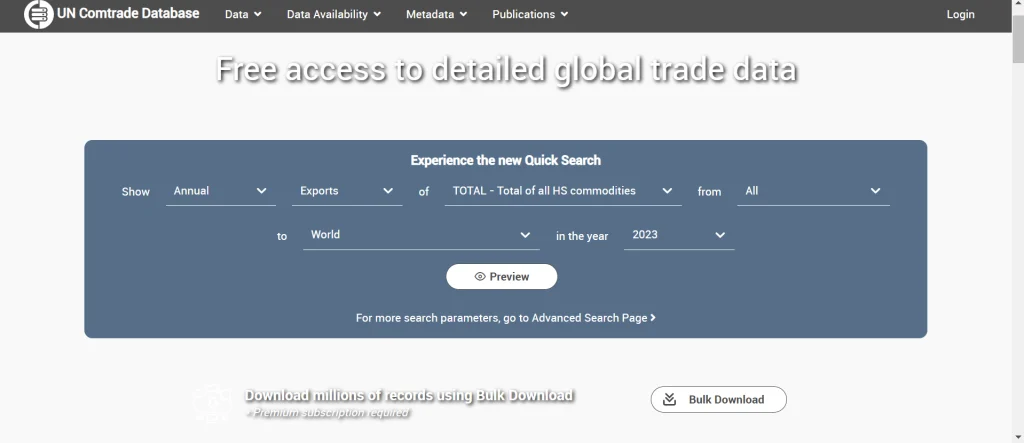Quick Guide: Comtrade export import Data
Export Import data is like a map that shows a country’s trading treasures. It’s a way to see what goods are moving in and out of countries around the world. One of the best tools for this purpose is the UN Comtrade database. Let’s explore what it is, how it works, and why it matters.
What Is UN Comtrade?
UN Comtrade stands for the United Nations Commodity Trade Statistics Database. It’s a treasure chest full of trade data from countries around the globe. Here, you can find detailed export and import statistics for different products. Every year, countries report their trade data to the UN, creating a massive collection of information that’s open for everyone to use.

Why Use UN Comtrade Export Data?
Visit the UN Comtrade Website: It’s like opening a big book of trade secrets.
Select Your Queries: Choose whether you want to see exports or imports, and pick specific countries or regions.
Filter Your Data: You can narrow it down by year, product type, or trade flow.
Download Your Findings: Once you’ve found what you need, you can download the data for further analysis.
Types of Data Available. If you’re involved in international business or just curious about global trade, UN Comtrade is super helpful. Imagine you want to know how much of a certain product your country exports compared to others. With this data, you can get clear insights into:
“Identify Market Opportunities”
By analyzing historical trade trends, you can anticipate shifts in the market, allowing you to make strategic moves before competitors.
The database provides access to trade flows between countries. You can identify the top exporting and importing nations for your products, giving you insight into market demand and untapped markets.
“Understand Competitors“
You can gain insights into competitors’ trading activities by examining the trade flows of goods similar to your offerings. Identifying which countries they are exporting to, at what price points, and in what quantities can help you adjust your pricing and targeting strategies.
“Optimize Sourcing”
- If you’re looking for new suppliers, UN Comtrade data can help you locate countries that export the raw materials or products you need. This enables you to compare prices and trade volumes from different sources to make more cost-effective decisions.
“Monitor Trade Policies”
- The platform provides data on tariff and non-tariff barriers, which are essential when entering new markets. Understanding a country’s trade policies can help you plan more effectively by avoiding markets with prohibitive regulations or tariffs.
“Track Product-Specific Trends”
- The Harmonized System (HS) codes available in Comtrade data allow you to track the movement of specific goods across borders. Whether you’re dealing in electronics, agricultural products, or machinery, this detailed information lets you fine-tune your import-export strategy based on the real-time performance of your products.
Getting started may seem daunting, but it’s actually pretty straightforward. Here’s a simple guide to help you navigate through the data:
UN Comtrade doesn’t just throw numbers your way; it offers various types of data. Here’s what you can expect to find:
Goods by Category: Products are divided into categories like textiles, electronics, or agricultural goods.
Quantities and Values: The database shows both how much of a product is traded and its monetary value.
Country Comparisons: Analyze how one country’s exports compare to another’s.
The Impact of Export Data on Businesses
For businesses, export import data is like having an inside scoop on the market. Knowing what products are in demand can help companies make strategic decisions. For example, if you find that your competitor is exporting a certain gadget, it might spark ideas for your own product line.
“How to Use UN Comtrade Data for Import-Export Business”
- Search for Trade Data by Product or Country
- Begin by entering specific HS codes or product names to find relevant trade data. You can also search by country to understand bilateral trade relationships and opportunities for your business.
- Filter the Results
- Use filters to narrow down your data by year, trade flow (import or export), and partner countries. This allows you to focus on the most relevant data, giving you a clearer picture of the market landscape.
- Analyze Data Trends
- Look for patterns in trade volumes, values, and market share over time. This will help you predict future demand, making it easier to decide where to expand next.
- Export Data for Further Analysis
- Comtrade Plus allows you to download data in various formats for further analysis. This is useful for creating custom reports or incorporating data into your business planning.
- Utilize Visualization Tools
- Comtrade Plus offers built-in visualization features to help you interpret complex datasets. Use charts and graphs to make more strategic decisions and communicate findings with your team.
Tips for Maximizing the Use of UN Comtrade Data
- Stay Updated: Markets change rapidly. Ensure you’re accessing the latest data available to keep up with trends and shifts.
- Use Multiple Data Sources: While UN Comtrade provides rich data, supplement it with other trade databases, market reports, and industry insights for a well-rounded strategy.
- Understand Limitations: While the data is comprehensive, some countries may have gaps or delays in reporting. Be mindful of these limitations when making decisions.
Final Thoughts
UN Comtrade export data offers a window into the bustling world of international trade. Like a well-organized library, it provides easy access to essential information for businesses, researchers, and anyone interested in trade dynamics. Harnessing this data can guide decisions, illuminate trends, and ultimately lead to success in the global marketplace. The world of trade is full of opportunities, and with the right information, you can seize them!
